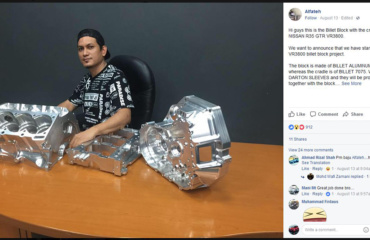EVO STROKER BUILD-UP

In this article we’ll highlight some of the differences between the newest generation 4G63 and the early 4G63 motors.
Here is one of our stage 3 Evolution engine blocks. This particular model is a stroker. We enlarged the bore to 3.366” and added 12mm more stroke to get roughly 2.3L of displacement.
Notice the proprietary Magnus pistons with the quench pad technology. These pistons are specifically designed for the Evolution engine, using experience we gained from working with the earlier 4G63 engines. The quench pad provides greater resistance to detonation and is basically an imprint of the head transferred to the piston. Why do we do this you ask? This helps squeeze all the gasses into a smaller space, making the combustion chamber smaller and more efficient.
Here is the Evolution 4G63 head, very similar to the old style head in casting but has a few major changes. First off we all know the flow is reversed. That won’t make any major changes to performance though. The injector bosses are now in the intake manifold instead of in the cylinder head. Placing the injectors a bit further back will give better atomization and also a bit more power. Although the 5 to 10 mm of distance that it has been moved to, to be able to get a measurable power gain would be splitting hairs… but it is an improvement nonetheless.
The intake ports have now been made a more normal size. The 1G port was always in our opinion too large to get good low end velocity out of. This head is much more of an improvement over the 1G DSM. The port entry angle is only 10 degrees; whereas the 2G DSM head had a much steeper entry angle, which was better for performance. A lot of manufacturers are getting away from steep angle intake ports which we can only guess for two reasons. A) Low hood line and less complexity for intake manifold castings or B) Emissions. Sharper angles will promote more tumbling and better atomization, aiding in emissions controls.
This picture shows finished intake ports displaying the 10 degree entry angle.
Here we see a finished Evo port up against a 1G DSM intake manifold flange for comparison. That’s a huge difference!
Here’s a finished EVO port and how it matches up against our CNC machined intake manifold flange. This image also visually shows the injector bosses.
The exhaust port is almost identical to the original 4G63 engine. Very little has changed except the bolt pattern which didn’t even change that much, its just reversed.
Here we take the Stage 3 Head and sit it down on the Stage 3 block. Now comes the task of checking clearances and degreeing the camshafts. We wanted this motor to run a 9:1 compression ratio so we opted for a .030″ gasket. Had we wanted to try 8.5:1 compression ratio, we would have installed our .060″ gasket.
After the piston clearances have been checked (our pistons allow high lift cams to be used without interference problems) we dry assemble the Timing belt pulleys and idlers temporarily so we can make degree in the cams, making sure they are installed at the manufacturers specs. This not only ensures that the engine will run properly and make power where it is supposed to, but it also ensures that you won’t have any clearance issues between the valves and pistons if your block and head have been decked a few times.
Now that we are sure the camshafts are degreed and installed correctly, we checked for valve clearance and it was more than adequate. Now it’s time to begin buttoning up the motor. The timing belt pulley are removed and the gasket is installed on the oil pump housing. The air separator baffle is installed (Very important do not omit this item, this prevents the oil pump from picking up air bubbles instead of straight oil) along with the oil pick up tube. We use a light coat of sealant on both sides of the front cover gasket, but always install the pickup gasket dry, so as not allow any sealant to get into the oil pump where it could instantly destroy the motor.
The oil pan is installed and the rest of the timing belt accessories are put back on for good this time, including the crank sensor. Notice our custom balance shaft eliminator plug. They are machined from 6061 aluminum in house. We use this instead of the Mitsubishi rubber plug because the rubber plug has a tendency to fall out and cause a gargantuan oil leak… at the most inopportune moments. Now that we no longer have balance shafts installed, this means the oil pump orientation when setting the belt is no longer critical. What’s different on the new 4G63 is the timing markings. You must have the rocker cover on to set the timing belt. Why? Because the rocker cover has the cam gear timing marks on it.
There it is all installed, belt on and ready to go, but wait there’s something missing.
There’s the Magnus EV0 8 stage 3 2.3 Stroker Motor with a sexy Intake Manifold attached to it. Now it’s ready to go with.. extra torque and horsepower!



